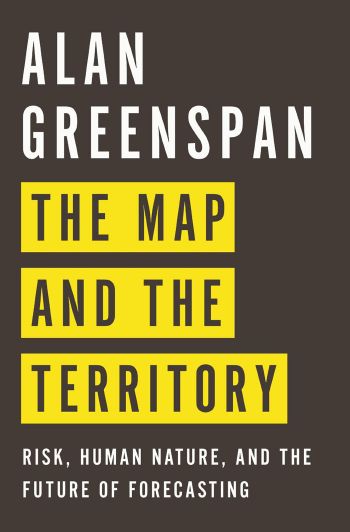If Greenspan had it to do all over again …
Book Review: Was Greenspan Fed too theoretical to predict Great Recession?
- |
- Written by Dan Borge
- |
- Comments: DISQUS_COMMENTS
 The Map and the Territory: Risk, Human Nature, and the Future of Forecasting. By Alan Greenspan. Penguin Press HC. 400 pp.
The Map and the Territory: Risk, Human Nature, and the Future of Forecasting. By Alan Greenspan. Penguin Press HC. 400 pp.
If you are a person who likes to unwind from a hard day’s work by curling up with a hefty economics tome, this book is for you. If you like footnotes, charts, and graphs, there are plenty here to please you as Alan Greenspan returns to his academic roots to lay out his newly revised views on potential uses and abuses of economic forecasting. Along the way, he offers his take on the world’s most pressing economic problems, from entitlement spending to the long-running Euro crisis.
Like the rest of us, Greenspan was surprised by the 2008 financial crisis.
Unlike the rest of us, he was Chairman of the Federal Reserve Board for 17 years, retiring in 2006, just two years before the crisis broke.
So while his candid confession of surprise is commendable, it is also unsettling coming from someone who occupied the most powerful and well-connected position in the global financial system.
He readily admits that “the Federal Reserve Board’s highly sophisticated forecasting system [built largely during his tenure] did not foresee a recession before the crisis hit.”
To his credit, he decided to find out how he got it wrong. This book is the result.
Starting from a flawed premise
Greenspan begins by saying that he relied too much on the assumption that economic decisions were primarily the result of rational calculations of self interest. He knew that individual decision makers were sometimes emotional and irrational, but he and many others believed that these deviations from rationality were essentially random and canceled each other out in the aggregate.
This was not the case, he says, in the financial crisis, where irrational behavior was systematic and widespread, driving some markets so far out of equilibrium that they ceased to function at all.
Greenspan borrows Keynes’ phrase “animal spirits” to describe several categories of behavioral propensities that can affect markets. These include: fear, euphoria, herding, optimism, self esteem, and others. In discussing these propensities, he deftly summarizes key insights of the field of behavioral economics, which started to gain traction in the late nineties and which is thriving today.
Greenspan’s hope is that learning more about these propensities offers the prospect of adding more realism to the economic modeling that forecasters rely upon. We shall see.
Pictures at an ugly exhibition—and bad brushwork
Greenspan then walks us through the events of the financial crisis and the failures that allowed it to happen. The events are depressingly familiar to anyone who followed the crisis closely, but his summary is a good one. The failures are also familiar: faulty credit ratings; faulty risk models; inadequate bank capital; overreliance on short-term financing; lack of regulatory foresight; and a perverse “too big to fail” policy.
His take on failed risk management is mainly that risk models were based on historical data that did not account for “tail risk”—rare events that produce exceptionally large losses.
This is true, but not the whole story. Another important factor was also at play: cultural weaknesses in managing the people who were supposed to be managing the risks.
Well before the crisis, all the big financial firms had installed risk management systems that ostensibly measured, tracked, and controlled the risks taken by the firm. They employed many highly trained risk experts to build and run these systems. What many firms did not do was pay attention to these systems when making actual business decisions. The culture rewarded revenue generation above all else, including prudent risk management.
Going beyond the financial crisis
Many chapters of The Map and the Territory are not about the financial crisis, per se, but about pressing problems in the global economy which might precipitate future crises. Among these are:
• The unsustainable rise in entitlement spending.
• The spread of crony capitalism as a result of government bailouts.
• Uncertainty about government policy that undermines investment and hiring.
• Regulatory overreach, as embodied in the Dodd-Frank Act.
• A slowdown in productivity improvement that is the source of new wealth.
• Increasing income inequality.
• The poisonous political environment that seems incapable of achieving consensus.
• The potential re-emergence of high inflation.
• The chronic crisis of the Euro.
The former Chairman has many worthwhile things to say about each of these many threads of his argument, but I wish he could have tied them together into a more coherent whole.
Will “animal spirits” analysis really work?
As it is, I remain skeptical about the prospects for much better economic forecasting. The prior record is dismal and I doubt that a better understanding of “animal spirits” will make much of a difference. The main problem, I think, is that the global economy is a very complex, constantly evolving, and chaotic system.
Small events can precipitate large surprises as longstanding imbalances suddenly become unsustainable. We may well gain a better understanding of what causes bubbles and become better at identifying them as they build, but knowing just how and when they will burst may continue to elude us.
Despite my quibbles, Greenspan has given us an important book that any student of the financial crisis should read. His policy prescriptions should be given a hard look by anyone concerned about the next financial crisis.
Tagged under Risk Adjusted, Books for Bankers, Risk Management, Blogs,














